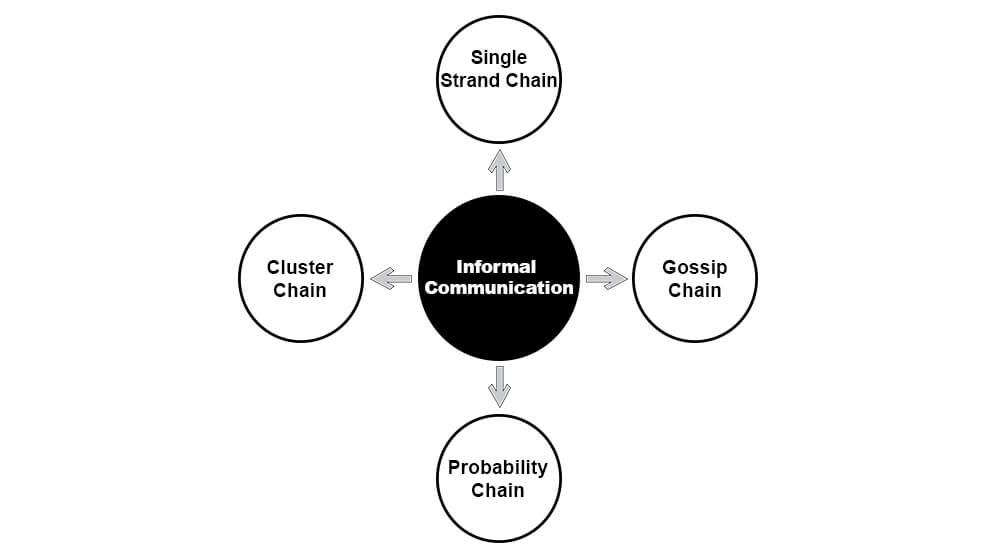Informal communication is casual communication among colleagues in the workplace. It does not follow any set rules, structure, or chain of command. For example, a chairman might chat with a junior employee.
This type of communication happens during casual talks, discussions, or social gatherings. It cannot be used as official evidence or record because it is not formally documented. Despite its informal nature, it plays an essential role in the workplace. Informal communication helps build strong employee relationships, boost morale, and create a positive and friendly work environment.
Informal communication encourages open conversations and exchanging ideas, leading to better teamwork and understanding. This type of communication is a key factor in maintaining harmony and improving collaboration within an organization.
Examples of Informal Communication
The following are a few examples of informal communication in the workplace:
- Casual Chats: Co-workers discuss their weekend plans or hobbies during lunch breaks.
- Friendly Jokes: Sharing light humor or jokes to create a relaxed environment.
- Quick Problem-Solving: Employees brainstorm ideas informally in a hallway or over coffee.
- Congratulatory Messages: Team members congratulate a colleague on a personal or professional achievement.
- Social Media Interactions: Colleagues exchanging comments or messages on workplace social networks.
- Mentorship: A senior employee giving informal advice to a junior during casual conversation.
- Team Celebrations: Informal discussions during team outings or birthday celebrations.
How is Formal Communication Different from Informal Communication?
Formal communication follows a structured format, official channels, and a chain of command. It is used for official purposes like sharing reports, policies, or instructions. Examples include emails, memos, or meetings with a set agenda. Formal communication is documented and can serve as evidence or record.
Informal communication is casual and unstructured. It occurs naturally during casual talks, discussions, or social interactions. It is not bound by rules or hierarchy, so anyone can communicate with anyone.
While informal communication boosts morale and helps develop a friendly work environment, formal communication ensures professionalism, clarity, and accountability in workplace interactions.
Types of Informal Communication

Informal communication can be categorized into four main types:
- Single Strand Chain: In this type, information is passed sequentially from one person to another in a straight line. For example, one employee tells another, who then relays it to the next person, and so on. This method can lead to distortion of the message as it travels.
- Gossip Chain: Gossip chain involves group conversations where individuals share information or rumors. It is common in casual or social discussions where the message spreads quickly among multiple people.
- Probability Chain: This type occurs when communication happens randomly. A person shares the message with anyone they come across, and it flows in all directions without a set pattern.
- Cluster Chain: In a cluster chain, an individual communicates with a selected group of people. These people then share the information with their chosen groups, creating a cluster effect. This type is the most common in informal communication.
Advantages of Informal Communication
- Promotes Relationship Building: Informal communication allows employees to engage in casual conversations, fostering trust and camaraderie. This strengthens interpersonal relationships and creates a sense of belonging in the workplace.
- Quick Information Sharing: Unlike formal communication involving structured channels, informal communication happens spontaneously. It enables swift sharing of information, especially during emergencies or time-sensitive situations.
- Boosts Employee Morale: Friendly discussions, jokes, and light-hearted interactions contribute to a positive work environment. They make employees feel valued and less stressed, enhancing their satisfaction and productivity.
- Encourages Innovation: When employees freely exchange ideas without formal constraints, they can brainstorm innovative solutions. Informal chats often provide a platform for creativity that formal settings might lack.
- Breaks Hierarchical Barriers: Informal communication bridges the gap between different levels of the organizational hierarchy. For example, a floor-level employee can casually share ideas or concerns with top management without feeling restricted by formal procedures.
Disadvantages of Informal Communication
- Lack of Accuracy: Since informal communication is unstructured, the message may change or become distorted as it passes through multiple people. This can lead to confusion and misunderstandings.
- Not Documented: Informal communication is verbal or casual, meaning no written record exists. This makes it unreliable for referencing or accountability in critical decision-making situations.
- Spread of Rumors: Gossip or unverified information can spread quickly through informal communication, potentially creating conflicts or damaging reputations within the workplace.
- Can Bypass Authority: Important decisions or updates might circulate informally, skipping approval from relevant authorities. This can result in miscommunication or conflict with organizational policies.
- Difficulty in Tracing Source: Since informal communication is spontaneous and lacks clear structure, identifying the source of the information becomes challenging. This can complicate problem-solving or accountability efforts.
Summary
Informal communication is the casual discussions among coworkers who are not bound by rules, processes, or chain of command. It can occur between employees at the same level or across different levels of the organization, developing connections based on social relationships.
This communication is vital in building relationships and creating a positive work environment. It gives employees a sense of belonging and strengthens their connection to the organization.
Although informal communication is uncontrolled and leaves no formal record, it encourages the free exchange of ideas. It promotes a collaborative workplace culture, boosts employee motivation, and contributes to the organization’s overall growth by enhancing team dynamics and morale.
